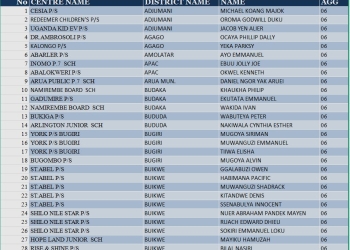
KAMPALA — Government has during the reading of the 2022/2023 National Budget indicated that the agriculture sector is expected to grow by 4.3 per cent, largely as a result of growth in food and cash crop production, livestock as well as recovery in fishing.
According to the budget presented by the finance ministry, the theme for the 2022/2023 national budget is; Full monetisation of the Ugandan economy through commercial agriculture, industrialisation, expanding and broadening services and digital transformation.
Unveiling the 2022/2023 National Budget, Finance Minister Matia Kasaija said the sector contributed 24.1 per cent to total economic output and a substantial amount has been allocated to the sector through Parish Development Model to spur the much sought-after social-economic transformation.
“I have allocated Shs. 564.39 billion to increase production and productivity through the Ministry of Agriculture, Animal Industry and Fisheries,” the Minister indicated, noting that agriculture production will be enhanced using the first pillar of the Parish Development Model – that addresses production, agro-processing, and marketing, through enhanced access and entry to national, regional and global markets.
“This value chain approach allows the development of sustainable linkages. The key interventions will include, the development of key commodities value chains that have a high impact on transforming the 39 percent of households in subsistence into the money economy”
These he said, include coffee, beef and dairy cattle, poultry, fish, piggery, fruits, and food crops for intensive farming. The rest of the enterprises including cassava, bananas, rice, Irish potatoes, millet, cotton, tea, cashew nuts, among others, will also be supported but for relatively big farmers.
The others he said, expansion of irrigation schemes and providing community and individual on-farm water for production to minimise reliance on rain-fed agriculture; and ensure sustained agricultural production.
Enhancement of research, breeding and appropriate technology development through the National Animal Genetic Resources Centre and Data Bank (NAGRC & DB) and the National Agriculture Research Organisation (NARO) is among the avenues to spur the sector.
Mr. Kasaija also said the promotion of appropriate land use, mechanisation, cooperatives, and development of partnerships with large-scale farmers to produce for export and industrial value addition; and supporting fishing communities by developing hatcheries, fish ponds, and equipping them with engines, nets is another avenue help the sector, a backbone of the country.
Last week on Tuesday during the State of the Nation address, President Museveni announced that Uganda had reached the lower-middle-income stage with a gross domestic product (GDP) per capita of $1,046 (sh3.7m). This development has since been contested by economic experts and researchers.
The Government is implementing Vision 2040 in a phased manner through a series of five-year development plans.
In Vision 2040, the Government planned to reach the upper-middle-income status with every Ugandan earning $9500 (sh35.1m) and with a poverty rate of only 5%.
The ministry indicates that the 2022/2023 national budget theme is derived from the NDP III theme of ‘increased household incomes and improved quality of life of Ugandans’.
As a result, the Government has earmarked a total of sh1,711b as wealth creation funds through various programmes.
The main vehicle for improving household incomes (wealth creation) in the 2022/2023 national budget is the Parish Development Model (PDM), which has been allocated sh1.059 trillion.
Through PDM, the Government will be investing in organised groups such as SACCOS and co-operatives, which are involved in agricultural production at parish level.
A total of sh72.7b has been allocated to the Microfinance Support Centre (MSC) to give low-cost credit to SACCOS.
In its reallocations in the budget, Parliament gave an extra sh35b to MSC to give out grants/donations to the beginning and struggling SACCOS.
The Government has also allocated an additional sh100b towards Emyooga programme to continue giving out funds to SACCOS, especially in urban areas or groups of people involved in similar economic activities.
The Presidential Initiative on Wealth and Job Creation (Emyooga) was launched in August 2019 as part of the broad government strategy, targeting to transform 68% of homesteads from subsistence to market-oriented production, with the overall objective of promoting job creation and improving household incomes.
The initiative is centred on various 18 categories/enterprises/Emyooga, covering majority of the hitherto, financially excluded Ugandans engaged in similar specialised enterprise categories.
These include market vendors, welders, taxi drivers, carpenters, bodabodas, women and performing artistes.
Other economic empowerment funds in the budget include sh30b to the Uganda Coffee Development Authority for the distribution of free coffee seedlings and sh30b for cattle restocking in Lango, Acholi and Teso sub-regions.
Another sh20b is for co-operatives, sh120b for the elderly persons, sh50b for Agriculture Credit Facility, sh48.7b for Uganda Development Corporation for the establishment of factories, sh34b for Women Entrepreneurship Programme and sh85b for Uganda Development Bank (UDB).
As part of interventions for resuscitating Uganda’s economy from the effects of COVID-19, the Government in 2020 allocated over sh530b to UDB to give low-cost credit to private businesses.
According to UDB executive director Patricia Ojangole, UDB’s capital base has now reached sh1.1 trillion.




















